All products featured are independently chosen by us. However, SoundGuys may receive a commission on orders placed through its retail links. See our ethics statement.
Samsung Galaxy Buds Pro vs Apple AirPods (3rd generation)
April 26, 2022
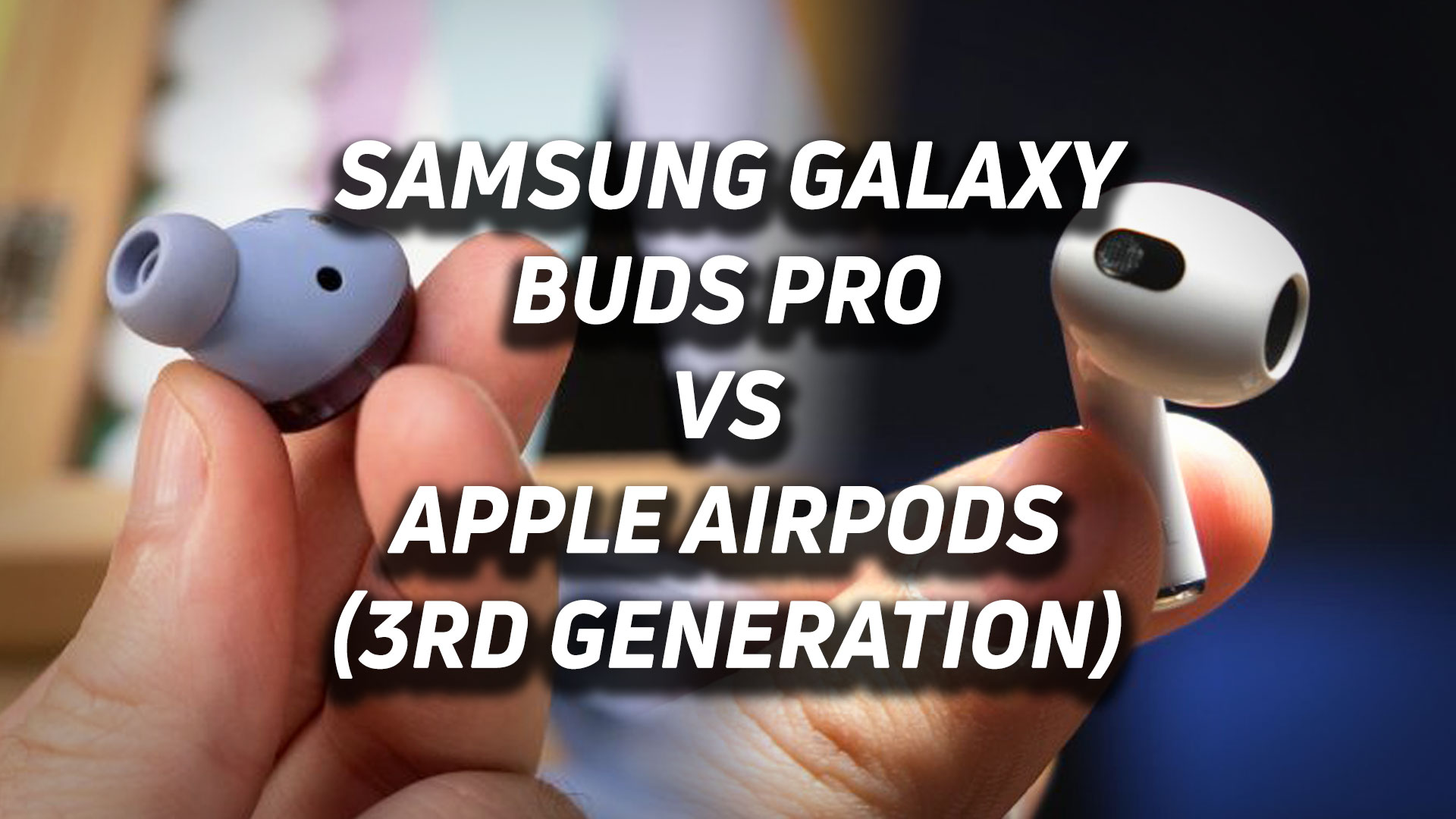
The important tech question used to be: Mac or PC? These days the question might as well be: do you like Apple iPhone or Samsung Galaxy? The short answer to the question of whether you ought to buy the Samsung Galaxy Buds Pro or Apple AirPods (3rd generation) largely depends on whether you’ve invested in the iOS or Android ecosystem. Each set of true wireless earbuds boasts features exclusive to their respective operating systems, Apple or Android, and in some cases, just Samsung. Let’s take a look at what you can or can’t do, as the case may be.
Editor’s note: this versus article was updated on April 26, 2022, to update mic poll results and to add a FAQ section.
What’s the difference between the Apple AirPods (3rd generation) and Samsung Galaxy Buds Pro?
Two very different design philosophies are at work with Apple and Samsung. The Apple AirPods (3rd generation) carries on the lineage of the most successful true wireless earphones, looking quite similar to the previous Apple AirPods generation and Pro variant (our AirPods Pro vs AirPods 2 comparison). Much has been said about this design, including the (not exactly) one-size-fits-all earbud design. For many, the fit feels precarious, and there is not much to be done about it.
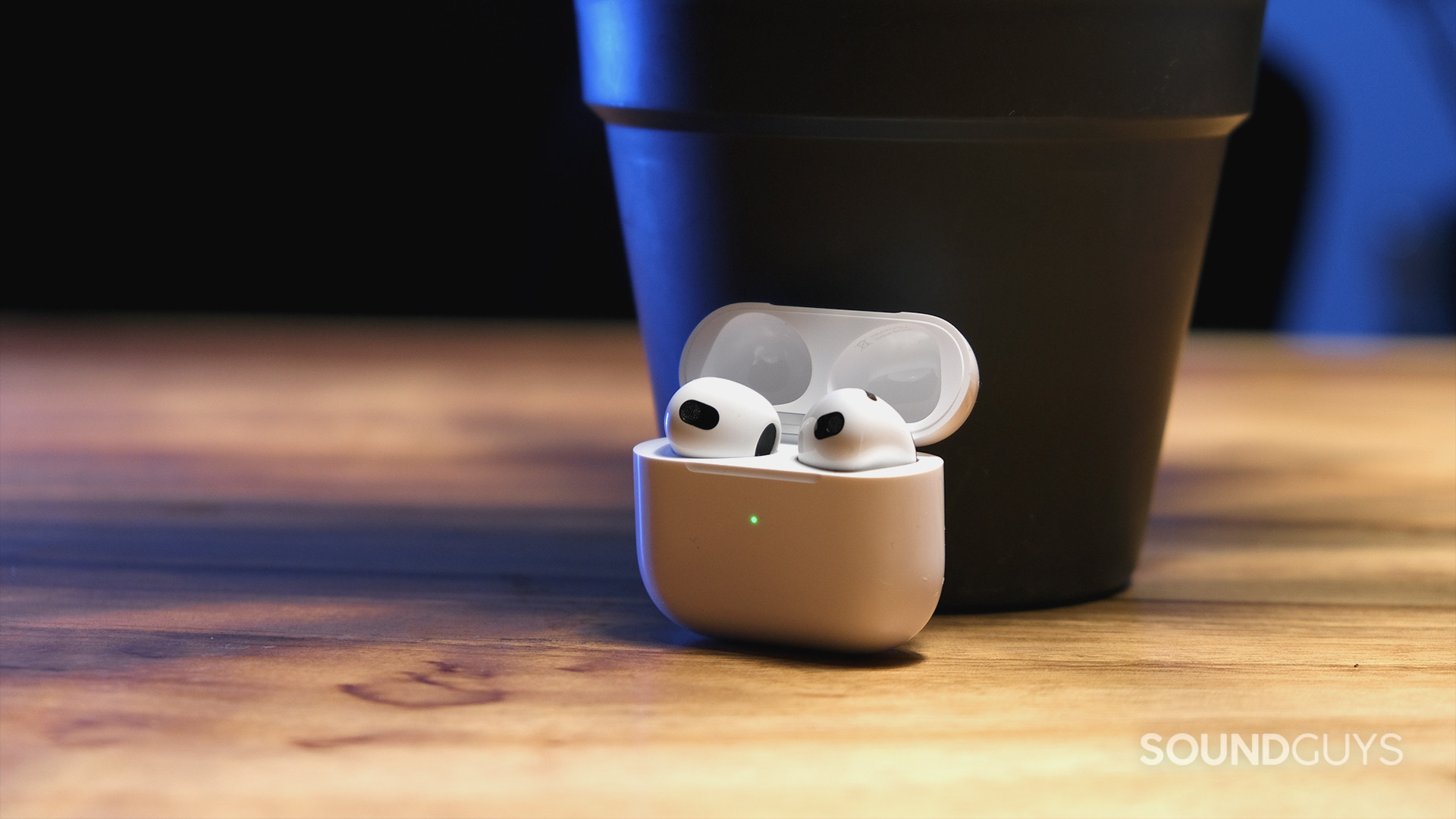
The AirPods (3rd generation) brings a few updates to the earbuds’ now-ubiquitous design. It has a shorter stem, which triggers commands through a variety of squeezes. A welcomed addition to the AirPods (3rd generation) is the IPX4 sweatproof rating. This means if you can get the buds to stay in, you can safely work out without damage.
The AirPods (3rd generation) case is now MagSafe-compatible, which really just means it works with Apple’s new magnetic Qi Wireless charging pad. It also has a Lightning input for wired charging and you can use it with a standard wireless charging. As of November 3, 2021, Apple doesn’t sell individual MagSafe AirPods Pro cases. The new AirPods case is the same as before with its signature glossy white plastic that resembles the AirPods Pro case, only narrower; we also discuss the cases in our AirPods Pro vs. AirPods (3rd generation) comparison.
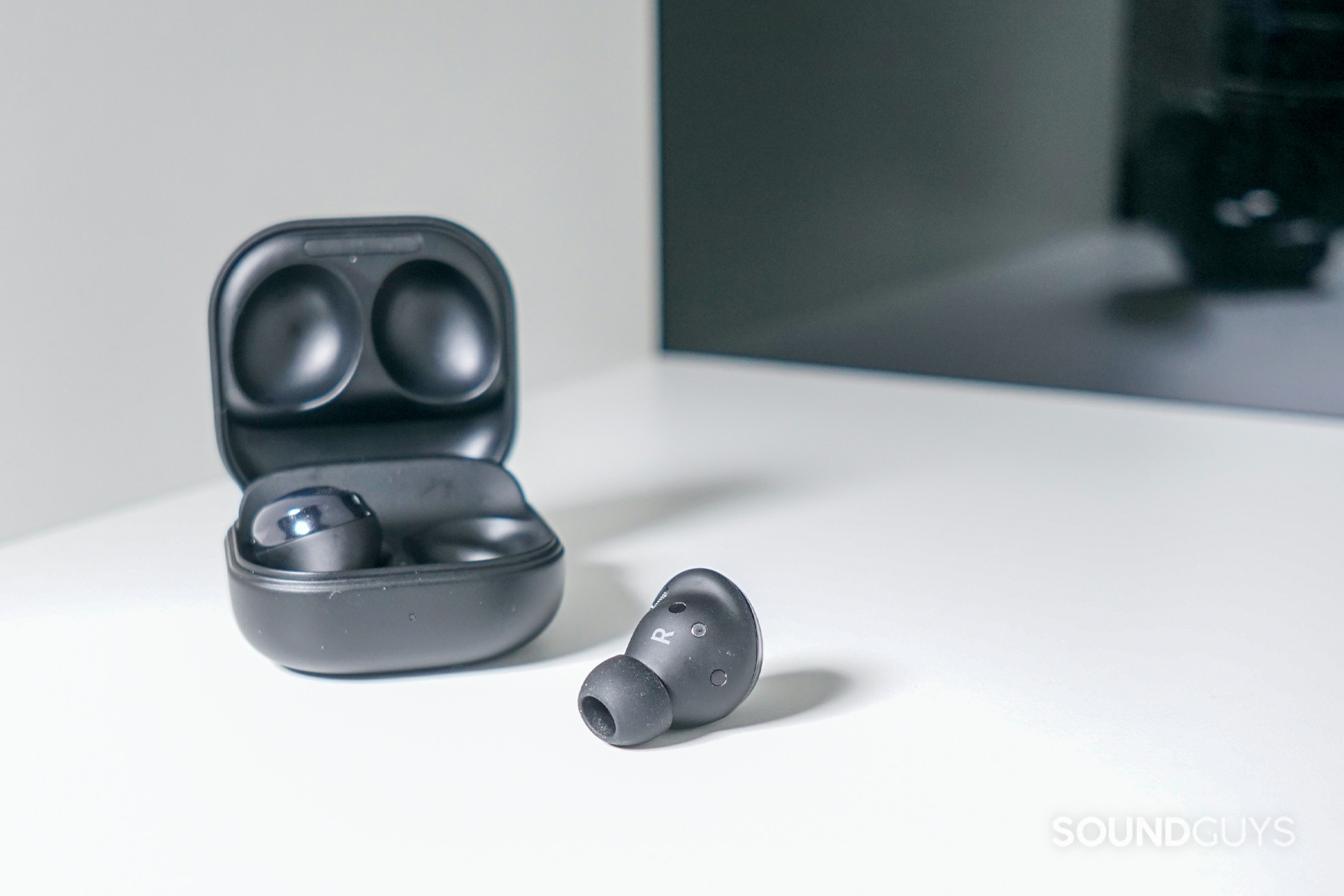
Looking very much from an alternate universe of true wireless earbuds, the Samsung Galaxy Buds Pro has no stem, and a wing tip shape built into each housing. The Galaxy Buds Pro has a more typical earbud shape that vaguely resembles products like the Jabra Elite 7 Pro. Unlike Apple, Samsung recognizes the importance of fit and includes what should be considered the bare minimum number of ear tips (three different sizes). Samsung also wins for its more extreme IPX7 rating, which allows you to drop the Galaxy Buds Pro in the pool.
The Galaxy Buds Pro has an Aware mode, while the AirPods (3rd generation) fits loosely with an open seal design, so you don't need any transparency modes.
Unlike Apple’s squeeze commands, the Galaxy Buds Pro uses taps. Unfortunately, the Galaxy Buds Pro touchpads are very sensitive, and they sometimes misfire commands. You can disable this function in the app, but you shouldn’t have to do so; Samsung should fix it. As it stands, Apple’s earbud controls are better.
The Galaxy Buds Pro case also has a plastic finish, but it has a more matte sheen compared to the AirPods case. The Buds Pro case supports wireless charging and wired charging with the nearly universal USB-C input. The case lid opens like a clamshell, which makes it easier to pick out the earbuds on a flat surface than the AirPods (3rd generation), which lays on its side. Single-handed, it might feel more ergonomic to hold the AirPods (3rd generation) case to replace or remove the buds.
What Bluetooth codecs do the Apple AirPods (3rd generation) and Samsung Galaxy Buds Pro use?
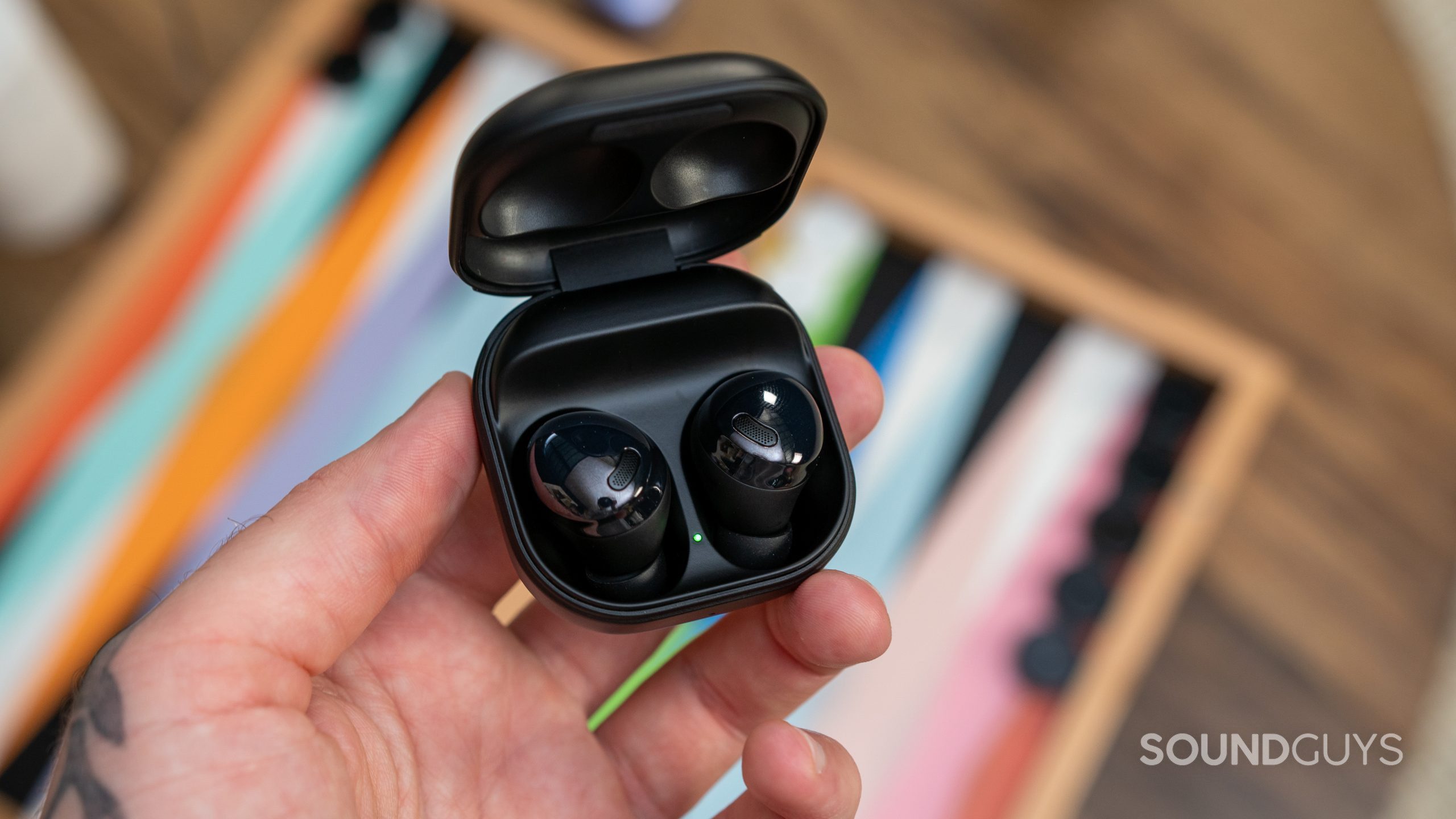
Both sets of true wireless earbuds use the AAC and SBC Bluetooth codecs. Here though is where the beginning of device dependency begins: Samsung also offers the Samsung Scalable Codec for folks pairing the Galaxy Buds Pro with another Samsung device. This codec optimizes audio quality based on the connectivity, and data transfer rates vary from 88-512kbps. It’s not exactly high resolution, but it makes video streaming and audio quality to a Samsung handset better than it would be over Android with AAC or SBC. While AAC is available on iOS and Android, it works unreliably over the latter. Android users might as well use SBC for consistent audio streaming rates. iPhone owners will default to AAC with both sets of earbuds.
When it comes to pairing, the AirPods (3rd generation) is snappy and pairs with your Apple device via the H1 chip. From then on, all Apple devices under the same iCloud account will recognize your AirPods. For FaceTime and phone calls on iOS, the AirPods (3rd generation) uses a new low latency codec, AAC ELD. Should you pair the AirPods (3rd generation) with Android or PC, you’ll press and hold the button on the back of the case and then select it on your device like any other Bluetooth headset. With the Samsung Galaxy Buds Pro on a Samsung phone, a pop-up notification will appear on your smartphone and ask if you want to pair earbuds to your phone. Like the AirPods (3rd generation), the Galaxy Buds Pro supports fast switching between Galaxy devices under the same Samsung account.
What apps do you need for the Apple AirPods (3rd generation) and Samsung Galaxy Buds Pro?
When you choose to buy the AirPods (3rd generation) you probably do it for the software. There’s no external app, instead you access functions through pre-installed Settings app in iOS. New to the AirPods (3rd generation), passed down from the AirPods Pro, is Spatial Audio with Dolby Atmos. This, along with the other features below run exclusive to Apple devices.
Tracks have to be specifically mastered as 5.1-channel, 7.1-channel, or for Dolby Atmos in order to work with Spatial Audio, but Apple also now includes a Spatialize Stereo function which essentially applies an algorithm to simulate the 3D sound to audio mastered in stereo or mono. Like all algorithms, its usefulness really varies. Generally speaking, it’s a fun trick, but we’re pretty sure the people who mixed the music to begin with know what they’re doing better. You might find it works for action movies reasonably well.
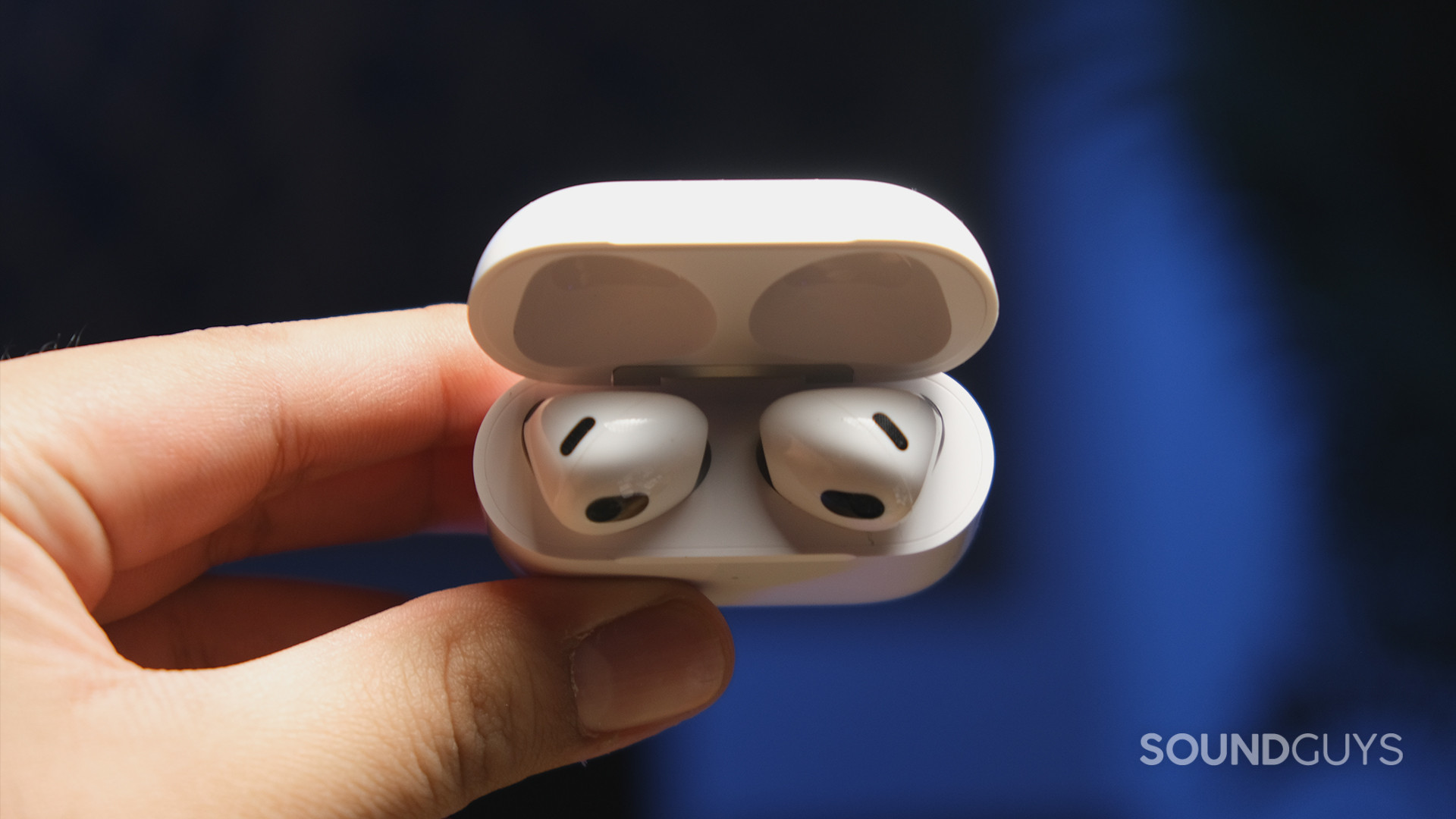
Another party trick Apple includes on the AirPods (3rd generation) is called Head Tracked, which basically uses the onboard accelerometers to adjust audio panning in relation to where you’re facing. Say you put on a live album with a lot of crowd sounds, if you turn your head to the right, the right channel’s signal reduces relative to your movement. It then pipes the proportion reduced on the right channel now into the left channel, essentially simulating what happens at a concert when you turn your head away from the stage. Its utility seems limited (and potentially distracting), but it’s immersive for live recordings.
You also get access to Siri on your iPhone by squeezing the left earbud. To get access to Google Assistant on your Android device you’ll have to ensure you’ve enabled it on the phone, but it won’t work as in-depth as Siri when paired with AirPods (3rd generation). Because you can’t customize anything on the AirPods (3rd generation) using Android, you’ll be stuck with the default settings.
Samsung and Android-exclusive features
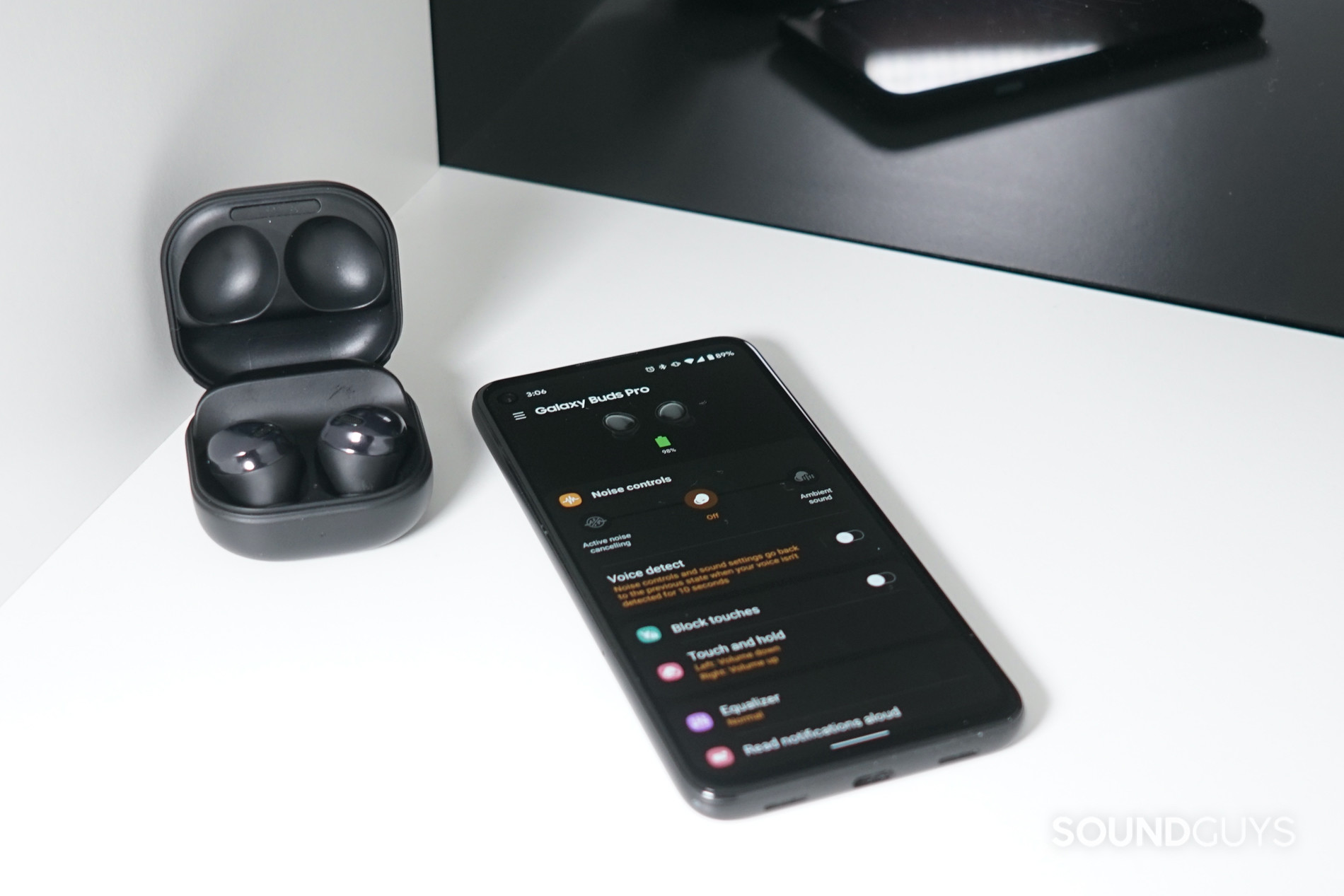
Like Apple, Samsung has limited access to some of its capabilities. Exclusive to users with Samsung devices is 360 Audio which also uses Dolby Atmos. It creates surround sound on both a horizontal and vertical plane, and much like Spatial Audio, audio has to be mastered for it specifically. In actuality, sources for Dolby Atmos mastered files and Spatial Audio are quite limited. For instance, you probably won’t find 360 Audio compatibilities on most music streaming platforms you use, and at the moment only a handful of shows and movies will work.
Less exclusive is the Samsung Galaxy Wearable app, which works for Android devices regardless of the manufacturer. There’s no iOS version, but hey, at least Android users don’t need a Samsung device to access features like EQ presets, which can appeal to audio tinkerers. You also get to control how much active noise cancellation (ANC) you want or toggle Aware mode.
Like the AirPods (3rd generation) you can use your preferred smart assistant, but Bixby has more integration on the Galaxy Buds Pro than Google Assistant. For those with accessibility needs you can change channel balance in the Galaxy Wearables app too.
Does the Samsung Galaxy Buds Pro have better active noise canceling than the Apple AirPods (3rd generation)?
Here you find a major difference between the Galaxy Buds Pro and AirPods (3rd generation). Simply, the Galaxy Buds Pro has ANC—two strengths of it—and the AirPods (3rd generation) doesn’t have noise canceling.
On the Galaxy Buds Pro you can also toggle ANC using a touch command. Combined with the passive isolation, this optimizes total attenuation. When set to high, the Galaxy Buds Pro can make low-frequency noises sound one-half to one-third as loud as they would without the earbuds. Isolation works well too, attenuating those high-pitched incidental sounds. Keep in mind only Android users can adjust the ANC in the app. All others will be stuck with default settings, which still let you turn ANC on and off using the touch controls.
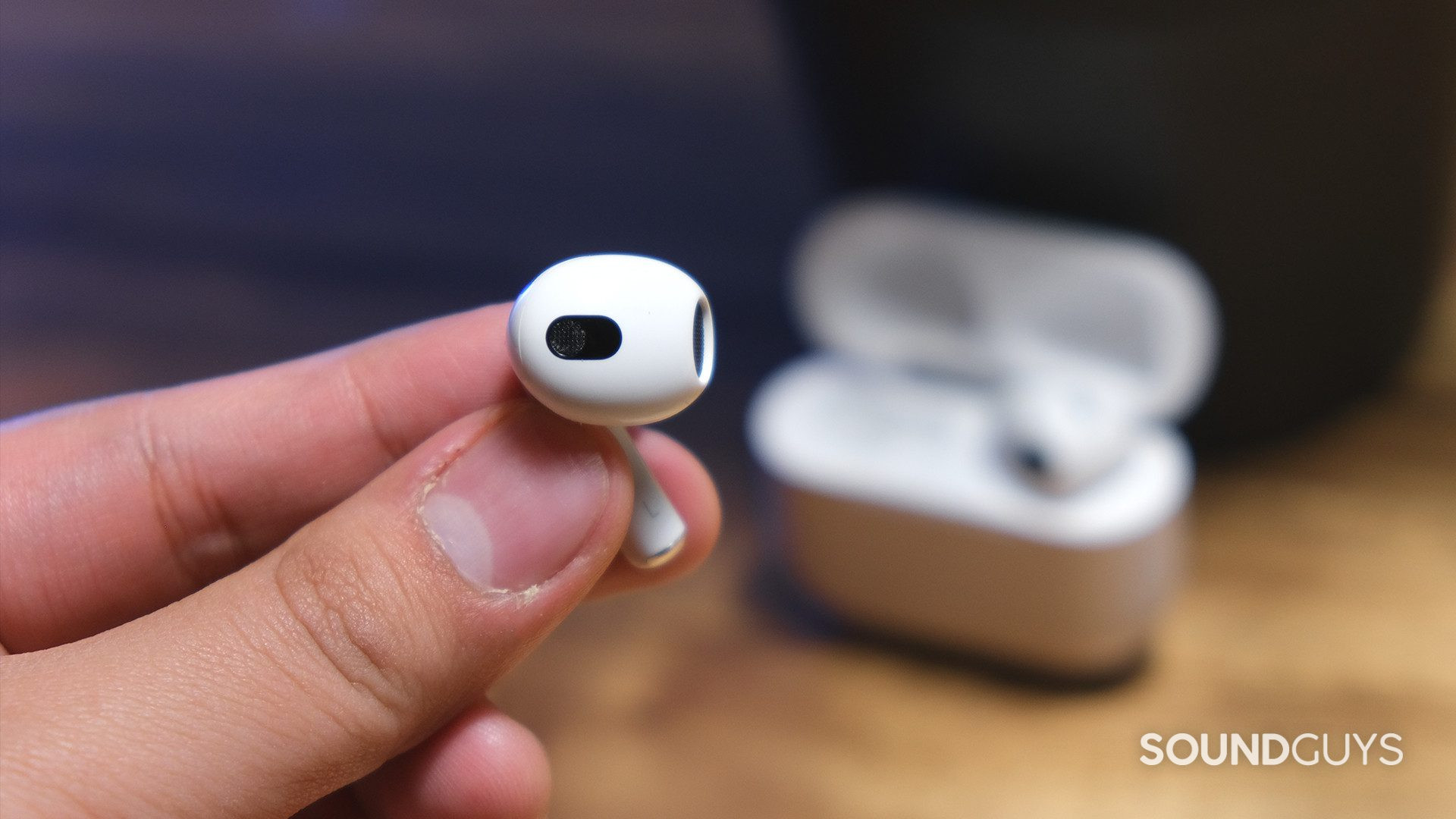
In contrast, the Apple AirPods (3rd generation) has zero noise cancellation, and its open seal design and one-size-fits-all policy mean it doesn’t isolate either. If you’re in a quiet environment that’s totally fine. However, you’ll likely need to crank up the volume to compensate for somewhere noisy. This is far from ideal, especially because ANC can help preserve your hearing by allowing you to keep your volume turned down. No ANC or isolation also means that your listening experience gets hampered by external noise.
Does the Galaxy Buds Pro or Apple AirPods (3rd generation) have better battery life?
Battery life on the Apple AirPods (3rd generation) lasted 6 hours and 21 minutes during our objective testing. Meanwhile, under the same conditions, the Samsung Galaxy Buds Pro lasted 4 hours and 48 minutes with ANC on. This might appear as if the AirPods (3rd generation) is a clear winner, but the Galaxy Buds Pro should last considerably longer than the 4 hours and 48 minutes measurement with ANC off. Samsung claims it should reach about 8 hours without ANC, though this varies with volume levels and how many software features you have enabled.
The AirPods (3rd generation) case provides an additional four charges to the earbuds, for more than 30 hours of juice. Fast charging also provides a full 60 minutes of battery life from only 5 minutes of charging in the case. The AirPods (3rd generation) is compatible with MagSafe charging, but you have to buy the MagSafe charging mat separately. Don’t worry: you can still use the third-generation AirPods case with a Qi charging pad, it just won’t have any magnetic properties.
With ANC on you get an additional 13 hours of listening from the Samsung Galaxy Buds Pro battery case. Presumably, the number is higher without ANC. The case also charges wirelessly with any Qi mat. Better yet, if you’re out and about, you can place the Galaxy Buds Pro case on top of your compatible Samsung Galaxy smartphone for Wireless PowerShare. This tops the earbuds and case up at the expense of your phone’s battery.
Does the Apple AirPods (3rd generation) or Samsung Galaxy Buds Pro sound better?
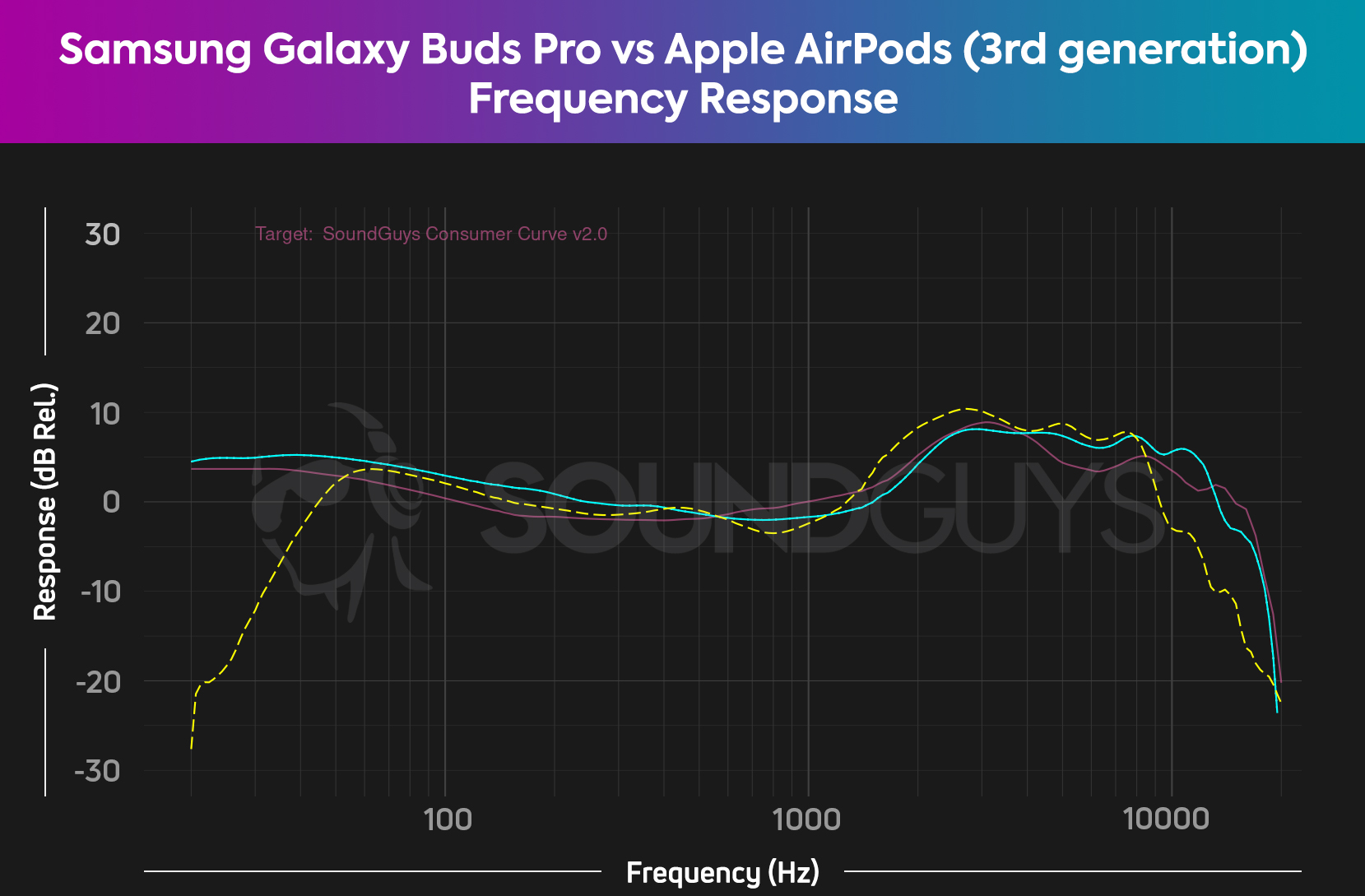
Your sound relies on how well your earbuds fit. Usually, earbuds come with variously sized ear tips to ensure a proper seal. Ideally, a seal means all frequencies reach you proportionate to how the headset manufacturer intended. With the Samsung Galaxy Buds Pro, you can more easily achieve that proper seal and therefore gain a more predictable outcome.
Using the AirPods (3rd generation) it’s difficult for everyone to get a good seal, so external sounds are likely to mask some frequencies—usually bass. Although, Apple designed the earbuds knowing the fit is terrible. The AirPods compensates with bass reflex ports at the top of each earbud and Adaptive EQ software. In general, however, you’ll hear less bass on the AirPods (3rd generation) than the Galaxy Buds Pro using its default voicing. Below 50Hz the AirPods (3rd generation) rolls off significantly, while the Galaxy Buds Pro follows our ideal frequency response with a healthy little boost in loudness.
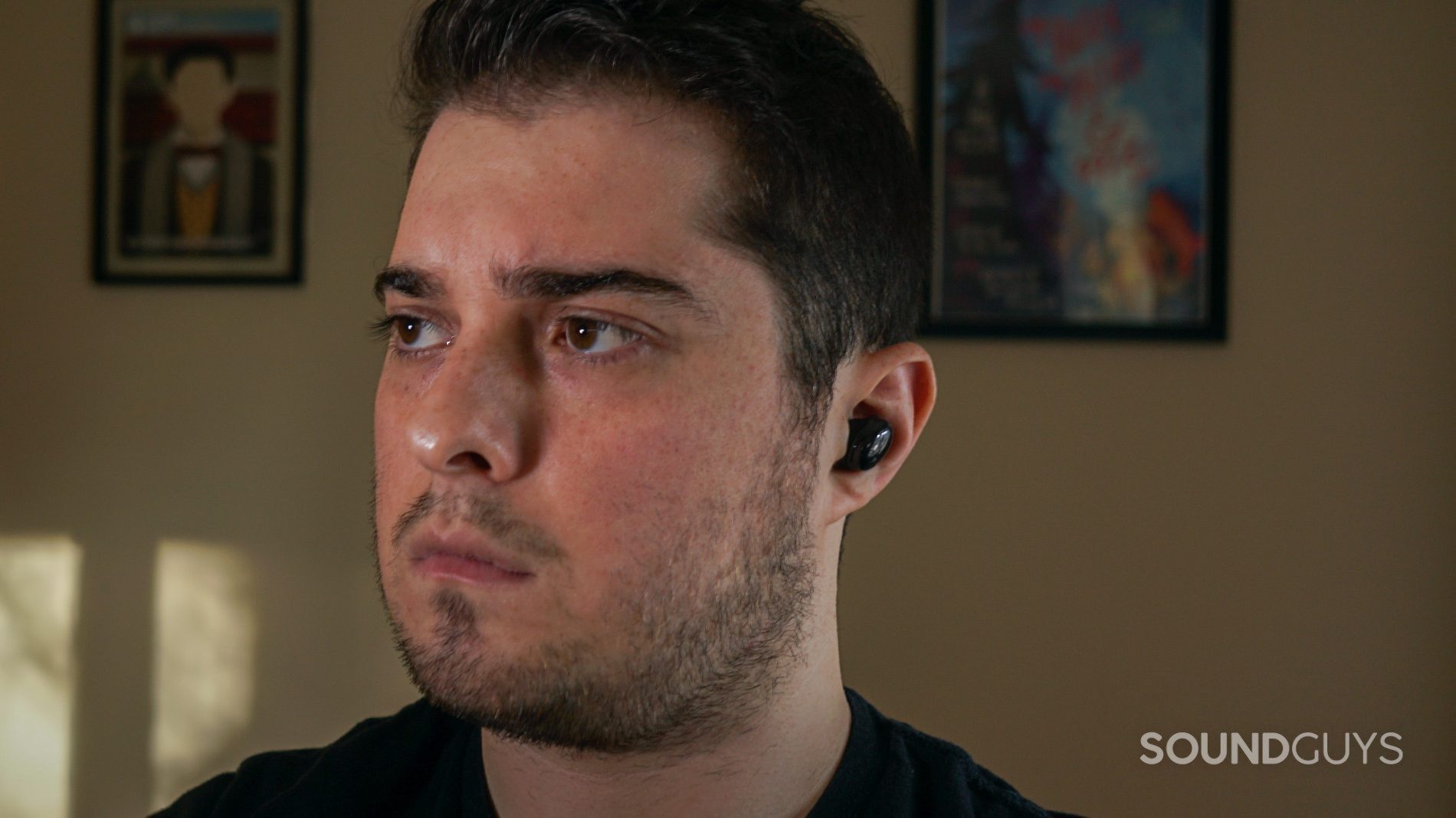
Apple’s Adaptive EQ is built into the buds and works automatically with every device you pair it with. That includes Android, PC, and of course, anything Apple. Some under-emphasis below 50Hz affects sub-bass, which is generally difficult for us to perceive, so it’s less dramatic than that chart might seem.
Through the mids, both sets of earphones sound similar to each other. In the highs, the AirPods (3rd generation) under-emphasizes frequencies, particularly above 8kHz, but otherwise reasonably follows our house curve. Meanwhile, the Samsung Galaxy Buds Pro also mimics our house curve, with extra emphasis around 10kHz and above. Here the sets deviate, with the Galaxy Buds Pro having both a more bass and treble-heavy sound than the AirPods (3rd generation). On balance, the AirPods (3rd generation) is designed more like a tiny speaker that rests outside your ear, than earphones.
Is the AirPods (3rd generation) better for phone calls than the Samsung Galaxy Buds Pro?
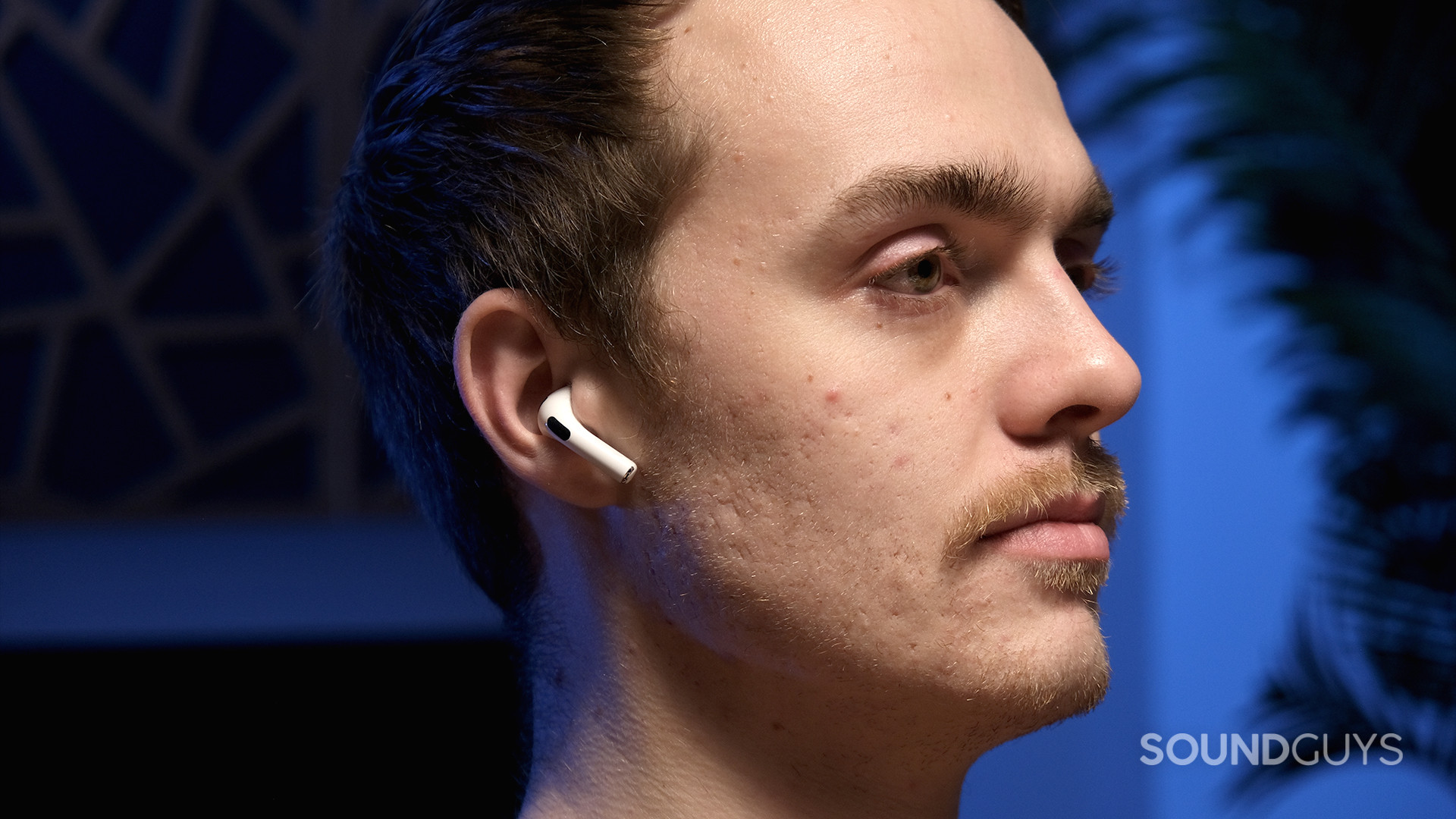
Microphone quality works well on both. While in no way will you be recording professionally with either pair of wireless earbuds, you can certainly use both for phone calls or Zoom. Listen to the samples below to cast your vote on which does a better job.
As of April 26, 2022, 58% of voters prefer the Samsung Galaxy Buds Pro microphone quality to the Apple AirPods (3rd generation).
Tell us what you think!
Apple AirPods (3rd generation) mic demo (Ideal):
Samsung Galaxy Buds pro mic demo (Ideal):
Which microphone sounds better to you?
Samsung Galaxy Buds Pro vs Apple AirPods (3rd generation): Which should you buy?
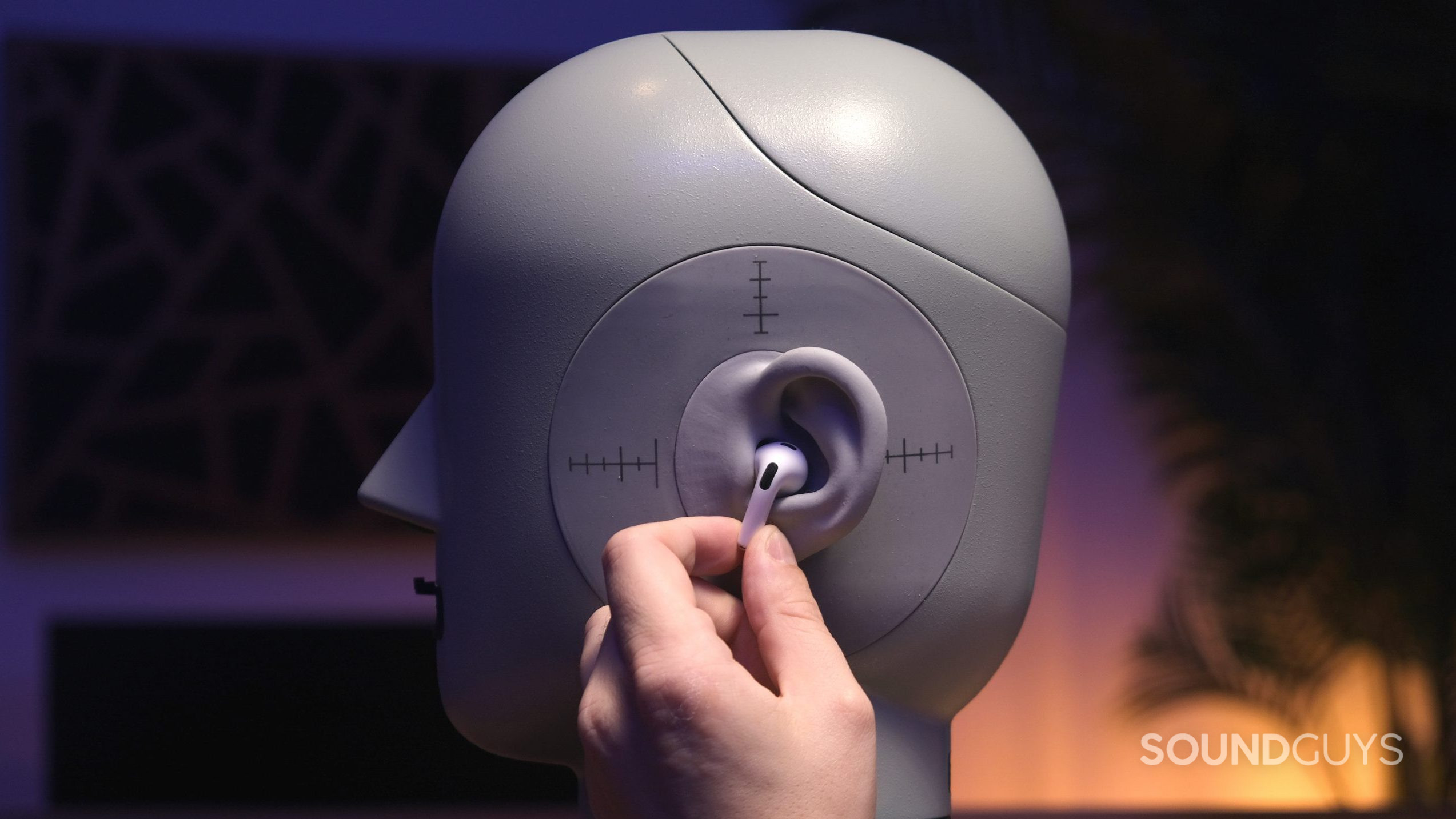
Your decision should largely come down to which ecosystem you’re devoted to. If you use Apple, it makes sense to benefit from the add-on features of the AirPods (3rd generation). You can’t access some of the features of the Galaxy Buds Pro unless you use Samsung or even Android. By the same token, there’s not much use in paying a premium for the AirPods (3rd generation) if you don’t own an iPhone.
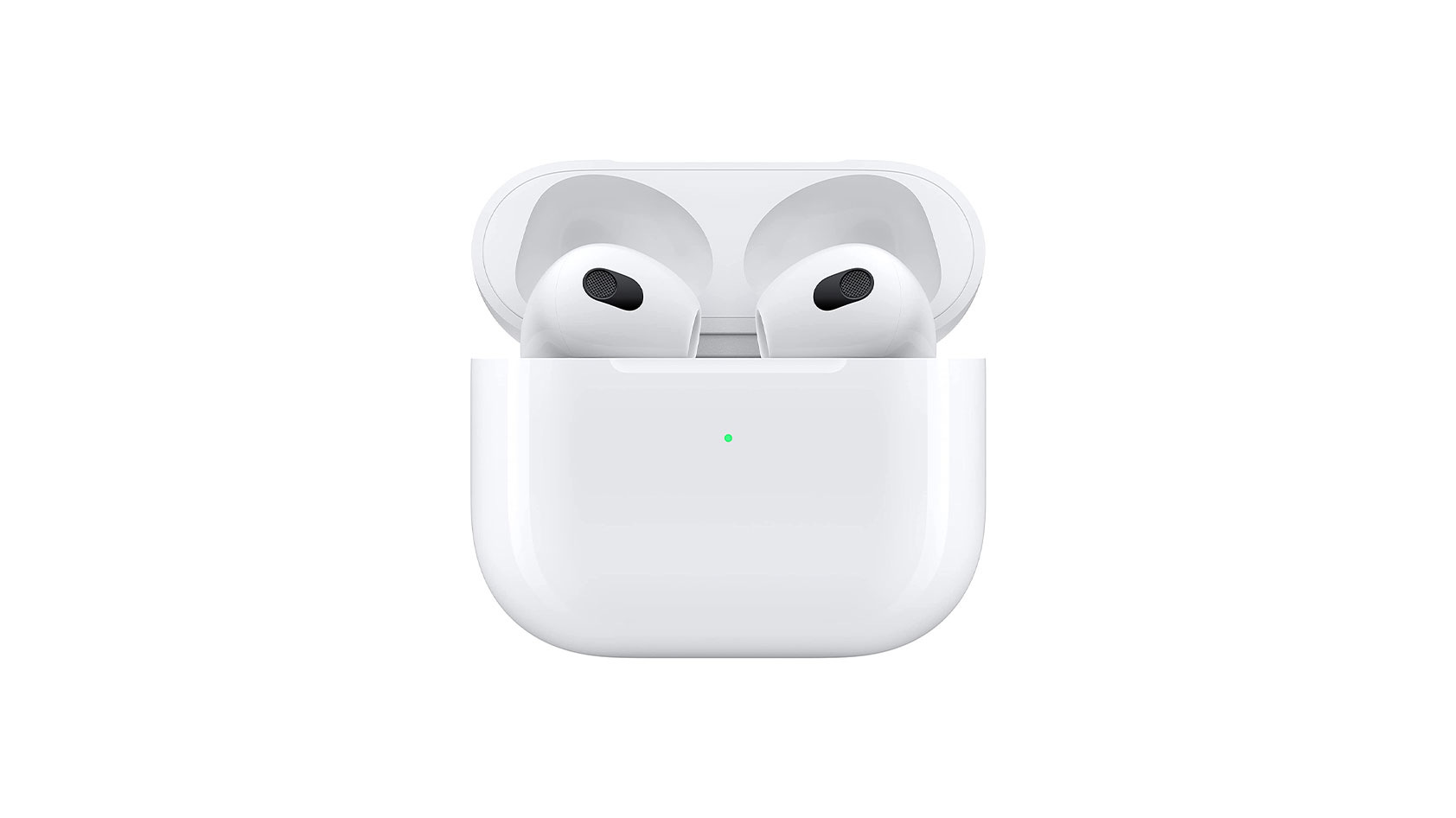
With all that out of the way, if you happen to be in the unique position of needing a new phone and new earbuds, save for the hypersensitive touch controls, the Samsung Galaxy Buds Pro (when paired with a Samsung device) offers more flexibility and a better fit. You’ll lose out on the Adaptive EQ, but you can use EQ presets in the app, and the buds will stay in much better. Unless you’re absolutely devoted to the Apple universe and want to use Spatial Audio with Apple Music, the Galaxy Buds Pro is just a better switch hitter for exercise, productivity, and music.
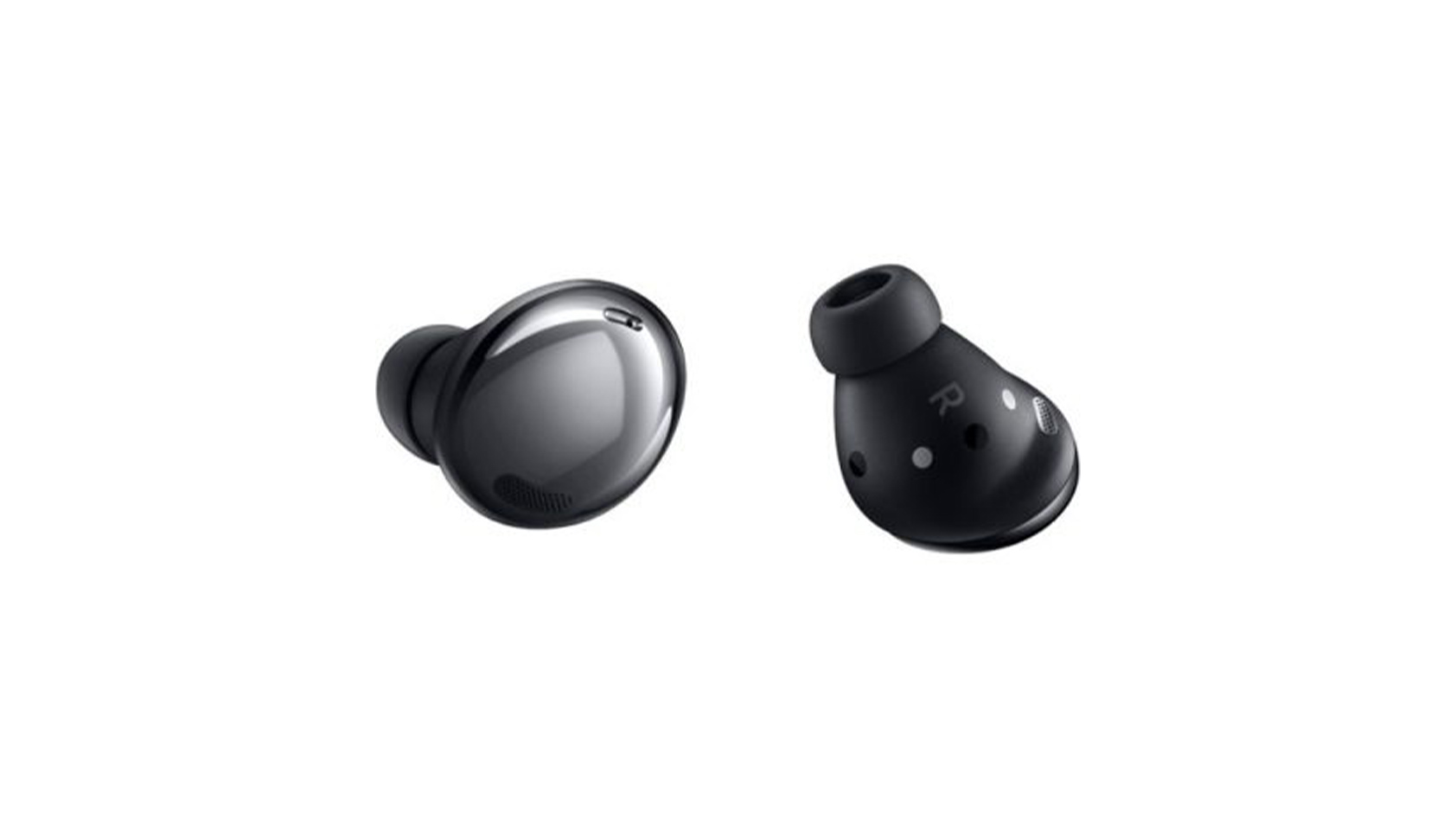
What should you get instead of the Samsung Galaxy Buds Pro or Apple AirPods (3rd generation)?
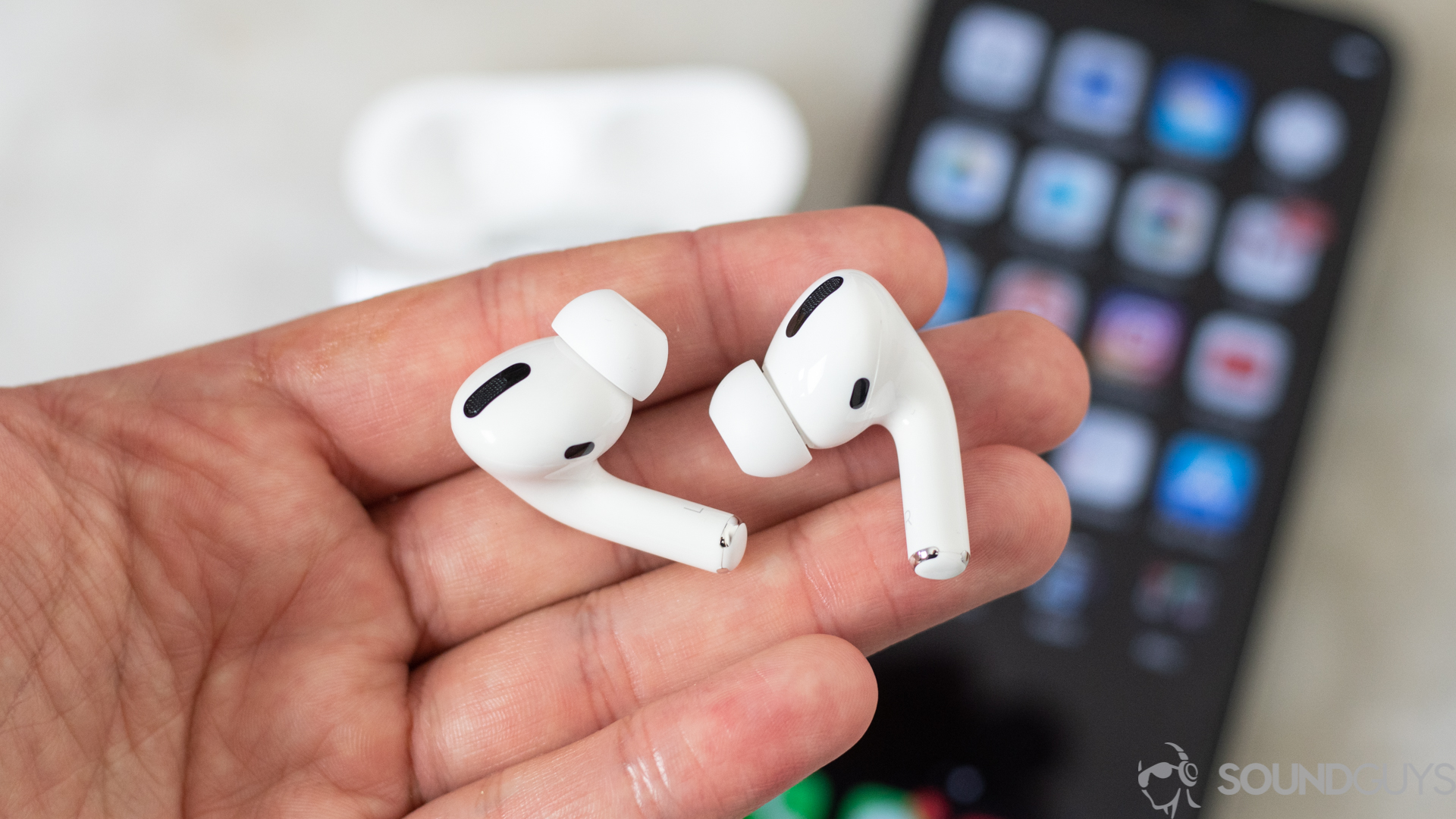
If you use an iPhone, just pay extra for the Apple AirPods Pro. It fits much better than the newest AirPods, sounds better, and has ANC to preserve your hearing. A fairer comparison would be the AirPods Pro versus the Galaxy Buds Pro, because their specs are closer. You’ll get all the fun tech with a more secure fit.
If you use Android, but maybe not a Samsung device, save a few bucks and pick up the Samsung Galaxy Buds 2 instead. This headset costs much less than $200 USD and you still get ANC and a similar frequency response. As mentioned, there’s a good chance you may not even use it. Like the Galaxy Buds Pro, the Galaxy Buds 2 does well against the AirPods (3rd generation) with better sound quality and isolation.
However, if you’re interested in higher quality codecs and premium features (at a premium price) you may also want to consider the Sony WF-1000XM4 with its good selection of codecs, useful app, and sound quality. Sennheiser also has the competitively priced CX Plus True Wireless which has great ANC and the aptX codec for high-quality audio, and its cheaper sibling without ANC, the CX True Wireless.
Frequently asked questions about Samsung Galaxy Buds Pro vs Apple AirPods (3rd generation)
Of course not every true wireless earbud purchase has to break the bank. For example, if you use Android you can get good sound, aptX codecs, and an IP55 rating with the Jabra Elite 3. Apple users should check for AAC codecs. On that note, check out some other solid budget friendly picks.
Yes, provided your meetings aren’t what you’re doing for most hours of your work day, both AirPods and Galaxy Buds Pro can work fine for meetings. The Galaxy Buds Pro has the added bonus of noise canceling, so if your environment is noisy while you’re in a meeting, at least you can turn on ANC to ignore the distractions while you listen. If you do a lot of meetings, it might be worth your while to upgrade for a better mic, a sidetone, or just a more comfortable over-ear fit.